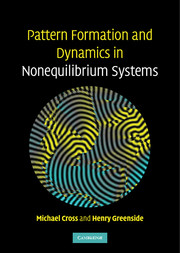Book contents
- Frontmatter
- Contents
- Preface
- 1 Introduction
- 2 Linear instability: basics
- 3 Linear instability: applications
- 4 Nonlinear states
- 5 Models
- 6 One-dimensional amplitude equation
- 7 Amplitude equations for two-dimensional patterns
- 8 Defects and fronts
- 9 Patterns far from threshold
- 10 Oscillatory patterns
- 11 Excitable media
- 12 Numerical methods
- Appendix 1 Elementary bifurcation theory
- Appendix 2 Multiple-scales perturbation theory
- Glossary
- References
- Index
8 - Defects and fronts
Published online by Cambridge University Press: 05 August 2012
- Frontmatter
- Contents
- Preface
- 1 Introduction
- 2 Linear instability: basics
- 3 Linear instability: applications
- 4 Nonlinear states
- 5 Models
- 6 One-dimensional amplitude equation
- 7 Amplitude equations for two-dimensional patterns
- 8 Defects and fronts
- 9 Patterns far from threshold
- 10 Oscillatory patterns
- 11 Excitable media
- 12 Numerical methods
- Appendix 1 Elementary bifurcation theory
- Appendix 2 Multiple-scales perturbation theory
- Glossary
- References
- Index
Summary
In this chapter, we will use the amplitude equations introduced in the previous two chapters to gain an understanding of defects and fronts in stripe patterns near onset. Our discussion also serves to illustrate more advanced applications of the amplitude equations, in particular the ability to treat patterns that vary spatially.
The importance of defects in patterns was introduced in Section 4.4.Adefect can be thought of as a local imperfection in an otherwise perfect pattern, and experimental and natural patterns often contain many defects, either due to the effect of boundaries or due to a spatially inhomogeneous initial condition. To approach the complicated realistic case of many defects, it is useful first to study single isolated defects and then attempt to build an understanding of natural patterns from these elementary ingredients. In Section 4.4.2, we introduced the notion of a topological defect, namely one that can be identified from properties of the pattern far from the location of the defect (such as the winding number of the phase, Eq. (4.58)), where the pattern approaches the ideal state. These defects are particularly important because they can persist for long times and so are robust. We will focus on two types of topological defects in stripe states, dislocations, and grain boundaries.
We first discuss the structure of stationary defects. Since defects represent deviations from the ideal pattern, the intensity of the pattern is reduced in their vicinity. The region over which the intensity is reduced, and where the pattern strongly deviates from the ideal one, is called the core of the defect.
- Type
- Chapter
- Information
- Pattern Formation and Dynamics in Nonequilibrium Systems , pp. 279 - 314Publisher: Cambridge University PressPrint publication year: 2009
- 1
- Cited by

